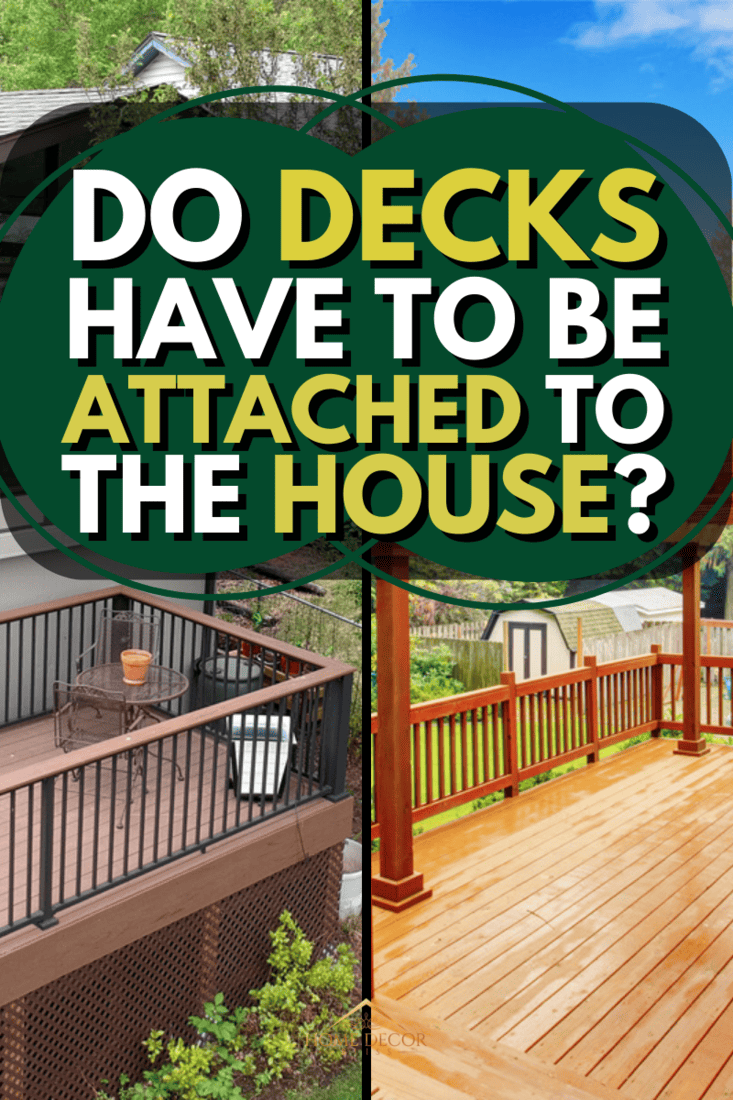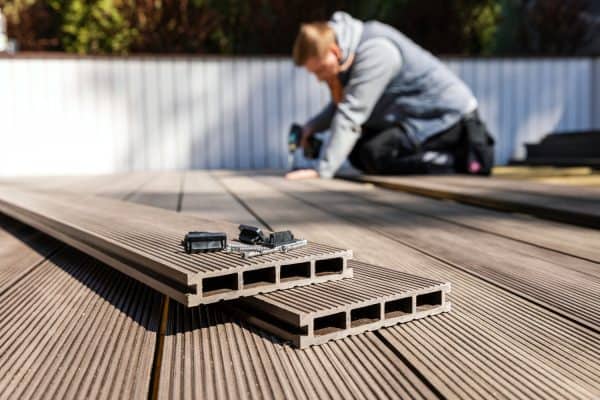A deck is a great addition to your yard for entertaining or relaxing. Often, decks are attached and become an extension of your home. But if you're wondering if a deck has to attach to your home, we've researched the topic thoroughly to provide an answer for you.
Decks do not have to attach to a house. Decks that do not attach to a building are called free-standing decks and support themselves. You can place them anywhere in your yard, and they are common around the edge of above-ground swimming pools.
Now, you know decks do not have to attach to the house. However, please keep reading as we delve into this topic further. We'll discuss why someone might choose not to have their deck attach. And we'll also answer related questions about freestanding decks. Let's begin!

What is a Freestanding Deck?
There are a couple of reasons you might have stumbled onto this blog. First, you're in the process of adding a deck to your yard, and you're considering adding a deck away from your home.
Second, you moved into a home that has a deck that doesn't attach to the house and you're wondering if it is safe. Let's go over what a freestanding deck is, so you can get a general idea of what you're dealing with.
Freestanding decks are decks that can support themselves without the aid of a structure. This means it does not have to be attached to a house.
When a deck attaches to a house or other building, the house supports half of the weight of the deck. This includes anything on the deck as well. For a freestanding deck to be safe, it will need extra footings and support in order to carry a full load of weight.
What is the Difference Between a Freestanding Deck and an Attached Deck?

We may include affiliate links and curated AI content to highlight top design styles.
The main difference between a freestanding deck and an attached deck is, as we mentioned earlier, that the attached deck is connected and supported by an additional structure.
If you were to look under a freestanding deck, you would see footings uniformly around the deck offering support. An attached deck uses the house as its additional footings.
If a deck is by itself, as in the image example above, away from any structure or around a pool, it is either a freestanding deck or a floating deck.
Why Choose a Freestanding Deck?

Freestanding decks are a popular choice because, if they are under a certain size, a building permit is unnecessary to construct one. Trying to obtain a building permit can be tedious and tricky.
It's possible to build a freestanding deck close enough to a house that it appears attached without the hassle of obtaining a building permit. There are still code requirements to meet, as per the international building code, however.
Homeowners might not choose a freestanding deck because the house is incapable of supporting an attached deck. This may be because of the style or the structural integrity of the home.
Another reason someone may choose to build a freestanding deck, it's because they are trying to build a deck elsewhere in their yard. For example, around the pool or just as an additional seating area.
What is a Floating Deck?

A floating deck is a freestanding deck that is close to the ground. Floating decks also do not require building permits as long as they are 30 inches or less from the ground.
Often, these decks get treated like patio areas because they provide the perfect spot for entertaining, dining, or seating.
Why Choose a Floating Deck?
Ground-level decks are a popular choice because they are more cost-effective than raised decks. Because of their close proximity to the ground, floating decks do not have stairs or railings.
Hence, they do not require extra resources for railings and stairs. Railings and stairs can also impact the view from the deck, so ground-level decks offer better views of the yard or surrounding area.
Can I Build a Deck Directly on the Ground?

Yes, you can build a deck directly on the ground. However, there are some important things to consider. You must use ground-contact treated wood. Untreated wood will rot. Rotten wood can cause a plethora of problems for you.
Elevating the deck so that the wood is not touching the ground is the best way to avoid issues with rot. You can use concrete blocks or a bed of gravel. It's important to note that even with concrete blocks, the beams of wood may still be in contact with the ground.
Do Ground-Level Decks Need Footings?
Floating decks, which are ground-level decks, do not need footings. You can use concrete blocks or deck blocks instead of footings.
For reference, if you plan on building a freestanding deck, the footings will need to be at least 12 inches deep. If you plan on building a standard deck, the footings will need to be deeper than the frost line.
Though ground-level decks do not need footings, adding footings can give them much more stability. So, if you want the deck to last and be a more permanent fixture, you may want to add footings, anyway.
Ground level decks also do not require stairs or railings because of their proximity to the ground.
Click here to see Deck Blocks on Amazon.
How Do You Build a Foundation for a Ground Level Deck?
Remove Grass
Prepare and Level the Ground
Place Blocks
The final step to creating a foundation for your ground-level deck is placing the concrete or deck blocks. At a minimum, you will need a block in each corner of your deck. Adding a block between the corner blocks and in the middle of the deck can add even more support.
Once you've placed them, you will need to make sure they are level. Use a level between each of the blocks to ensure they are even, and your deck will not slope.
Click here to see a Level on Amazon.
Do Deck Posts Need to be Anchored?

It's essential to anchor deck posts. Anchoring the deck posts ensures the deck can safely hold itself, any people, and any furniture placed on it. Anchoring the posts also ensures there will not be any lift of the deck if the wind picks up.
Setting the posts in concrete is not enough to support your deck. The concrete will eventually fail, which can result in your deck collapsing. Anchoring deck posts help prevent your deck from rotting, collapsing, or failing during high winds or other weather events.






![cement deck block foundation installed on, How To Use Concrete Deck Blocks [A Detailed Guide]](https://homedecorbliss.com/wp-content/uploads/2022/11/cement-deck-block-foundation-installed-on-600x400.jpg)
